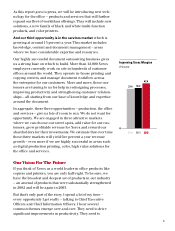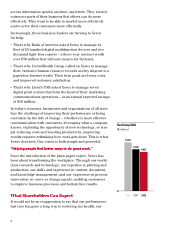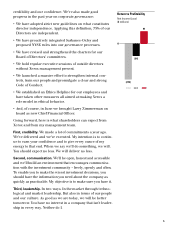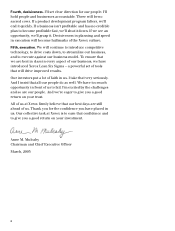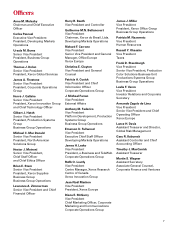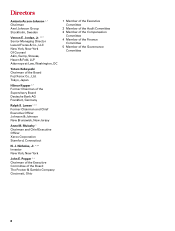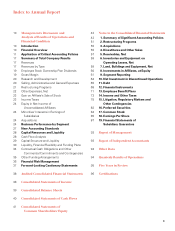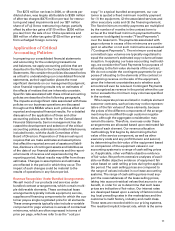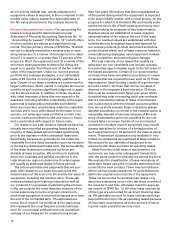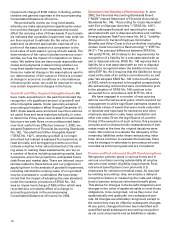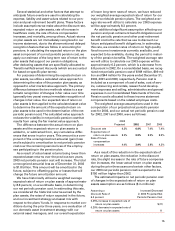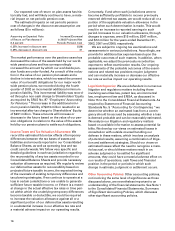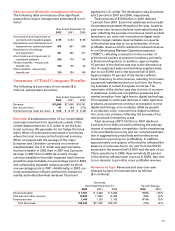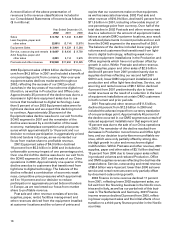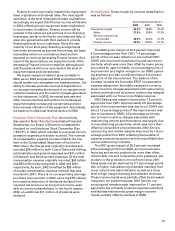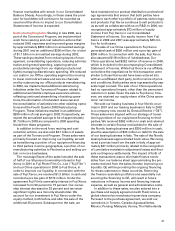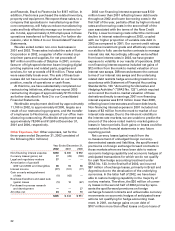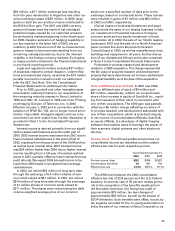Xerox 2002 Annual Report Download - page 15
Download and view the complete annual report
Please find page 15 of the 2002 Xerox annual report below. You can navigate through the pages in the report by either clicking on the pages listed below, or by using the keyword search tool below to find specific information within the annual report.
13
Accounts and Finance Receivables Allowance for
Doubtful Accounts and Credit Losses: We perform
ongoing credit evaluations of our customers and
adjust credit limits based upon customer payment
history and current creditworthiness. We continuous-
ly monitor collections and payments from our cus-
tomers and maintain a provision for estimated credit
losses based upon our historical experience and any
specific customer collection issues that we have iden-
tified. While such credit losses have historically been
within our expectations and the provisions estab-
lished, we cannot guarantee that we will continue to
experience credit loss rates similar to those we have
experienced in the past. Measurement of such losses
requires consideration of historical loss experience,
including the need to adjust for current conditions,
and judgments about the probable effects of relevant
observable data, including present economic condi-
tions such as delinquency rates and financial health
of specific customers. We recorded $353 million,
$506 million and $613 million in the Consolidated
Statements of Income for provisions for doubtful
accounts for both our accounts and finance receiv-
ables for the years ended December 31, 2002, 2001
and 2000, respectively, of which $332 million,
$438 million and $472 million were included in Selling,
administrative and general expenses for such years,
respectively. The declining trend in our provision for
doubtful accounts was primarily due to improved cus-
tomer administration, collection practices and credit
approval policies, as well as our revenue declines.
Historically, about half of the provision for doubtful
accounts relates to our finance receivables portfolio.
This provision is inherently more difficult to estimate
than the provision for trade accounts receivable
because the underlying lease portfolio has an average
maturity, at any time, of approximately two to three
years and contains past due billed amounts, as well
as unbilled amounts. Estimated credit quality of any
given customer and class of customer or geographic
location can significantly change during the life of
the portfolio. We consider all available information in
our quarterly assessments of the adequacy of the
provision for doubtful accounts.
Provisions for Excess and Obsolete Inventory Losses
and Residual Value Losses: We value our inventories
at the lower of average cost or net realizable value.
We regularly review inventory quantities, including
equipment to be leased to customers, which is includ-
ed as part of finished goods inventory, and record a
provision for excess and/or obsolete inventory based
primarily on our estimated forecast of product
demand and production requirements. Several fac-
tors may influence the realizability of our inventories,
including our decision to exit a product line, techno-
logical changes and new product development. These
factors could result in an increase in the amount of
excess or obsolete inventory quantities. Additionally,
our estimates of future product demand may prove to
be inaccurate, in which case we may have understat-
ed or overstated the provision required for excess and
obsolete inventories. In the future, if we determine
that our inventories have been overvalued, we would
be required to recognize such incremental costs in
cost of sales at the time of such determination.
Likewise, if we determine that our inventories are
undervalued, we may have overstated cost of sales in
previous periods and would be required to recognize
such additional operating income at the time of sale.
Although we make every effort to ensure the accuracy
of our forecasts of future product demand including
the impact of future product launches and changes in
remanufacturing strategies, significant unanticipated
changes in demand or technological developments
could significantly impact the value of our inventory
and our reported operating results if our estimates
prove to be inaccurate. We recorded $115 million,
$242 million and $235 million in inventory write-down
charges for the three years ended December 31, 2002,
2001 and 2000, respectively. The decline in inventory
write-down charges was primarily due to the absence
of business exiting activities, stabilization of our prod-
uct lines, Flextronics-related improvements and a
lower level of inventories. At this time, management
does not believe that anticipated product launches will
have a material effect on the recovery of our existing
inventory balance.
We have a similar accounting policy relating to
unguaranteed residual values associated with equip-
ment on lease, which were $272 million and $414 mil-
lion in our Consolidated Balance Sheets at December
31, 2002 and 2001, respectively. We review residual val-
ues regularly and, when appropriate, adjust them
based on estimates of expected market conditions at
the end of the lease, including the impacts of future
product launches, changes in remanufacturing strate-
gies and the expected lessee behavior at the end of the
lease term. Impairment charges are recorded when
available information indicates that the decline in
recorded value is other than temporary and we would
therefore not be able to fully recover the recorded val-
ues. We recorded $26 million, $14 million and $17 mil-
lion in residual value impairment charges for the years
ended December 31, 2002, 2001 and 2000, respectively.
Asset Valuations and Review for Potential
Impairments: Our long-lived assets, excluding good-
will, are assessed for impairment by comparison of
the total amount of undiscounted cash flows expected
to be generated by such assets to their carrying value.
During 2002, due to our decision to abandon the use
of certain software applications, we recorded an


